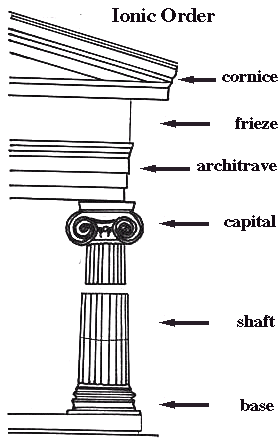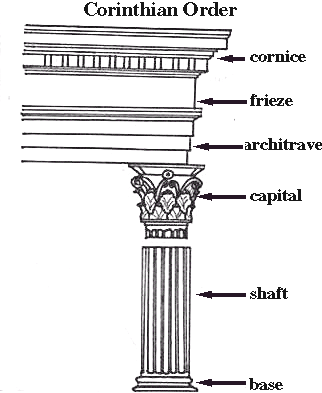The Greek people were not only skilled soldiers, philosophers, and inventors, but they were also skilled architects with many buildings that have survived to this day. Here we shall look at three different orders of columns seen in Greek buildings.
The first and earliest of these is the Doric order. The Doric order first appeared about 400 BC when the Greeksfirst began using stone in their buildings instead of wood. Compared with the later orders Doric is rather simple, but in the time frame that it first appeared it was most complex. With the advent of the Doric order temples began changing from the shape of a hairpin to a long rectangle. Archeological evidence shows that the capitals or tops of the Doric columns were often heavily customized, which was a first in Greek architecture. A good example of an early building that uses the Doric style is the Temple of Aphaia in Aegina and good later example is world famous Parthenon in Athens.

The next order is the Ionic order. The Ionic order was invented by the peoples living on the Ionian Islands in the Aegean Sea. This order was based heavily on the architecture of Egypt and Persia and this was reflected in the tall slender shape. This quality allowed for bigger and taller buildings and this was shown in the truly large temples of the 6th century BC (they could get as large as 55 by 112 meters!). Columns of the Ionic order were typically more decorative than Doric columns and therefore they were used in many public buildings in the Greek world. The temples on the Ionian island that date from the 6th century are good examples as is theTemple of Athena Nike in Athens near the Parthenon.

The last and final order was the Corinthian order. The Corinthian order appeared in the time following the tumultuous 5th century and the extravagance of the columns reflected the determination of the Greeks to surpass their predecessors. The Corinthian columns were wider then the Ionic ones and had a capital that was usually decorated with such things as flowers, leaves, and scrolls. Because of the beauty of the columns many cities that were damaged during the 5th century were often rebuilt with these columns. The Greeks however were not the main users of the Corinthian order, the Romans were. The Romans often used the Corinthian style along with their own unique architecture, taking it with them as Roman power expanded across the ancient world. Several temples in Greece and the Ionian islands dating to after the 5th century use the Corinthian style and many of the columned buildings built by the Romans use the Corinthian style also. A good example of a building that uses the Corinthian style is the Temple of the Sybil in Rome.

In closing the architecture of the Ancient Greeks has had a great impact on architecture ever since. This is shown in many government buildings and even some churches throughout Modern Europe and the United States.

